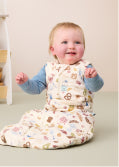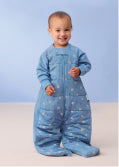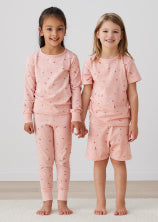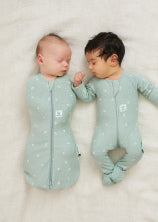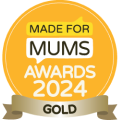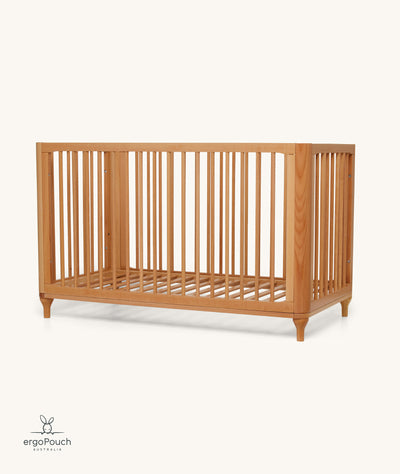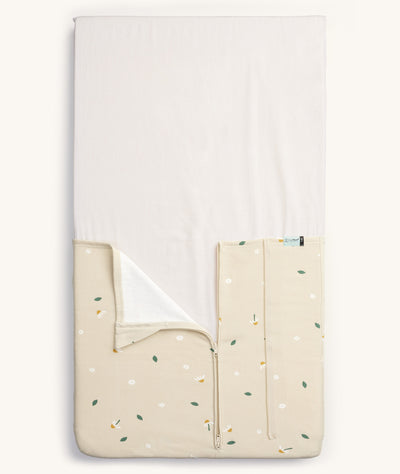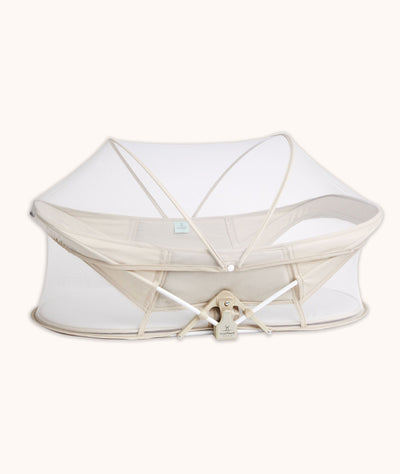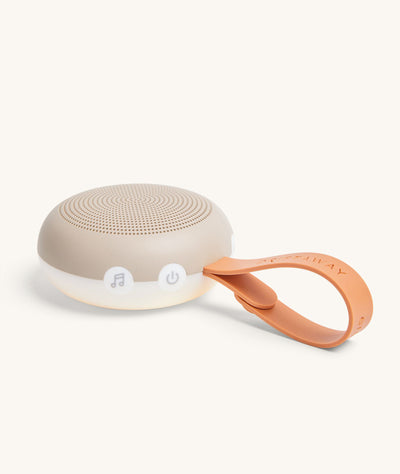
Hi! If you're new here, welcome. Perhaps you're expecting your first mini, you're adding to your family and need a quick refresher, or your baby is about to have a baby, and you want to relearn to lend a hand congratulations to all of you!
Whatever the reason, we understand how overwhelming it can be whenever a baby is on the way. Our job is to guide you through the process of swaddling and answer all your burning questions. As many of us are parents ourselves, we've been where you are, and we want to ensure you feel supported as you enter into this journey of newborn sleep.
What is swaddling and why do it?
Swaddling is the traditional practice of securely wrapping your baby in a blanket, wrap or zip-up swaddle (like our Cocoon Swaddle Bag), to help them feel safe and settled for sleep. We swaddle our babies to avoid the sudden flailing of their arms and head that swiftly snaps them awake, undoing all that hard work it took to get them to sleep. That flailing movement is known as the startle reflex. It is a jerk in their bodies that can occur every 20 minutes in some babies. It is completely normal and begins in the first trimester in utero. A loud noise, a sudden bright light, movement or even a parent laughing can trigger the reflex. Swaddling calms this jerking movement while keeping your mini comfortable and content.
The transition from the cosy confines of the womb to life outside can be anything but easy for newborns who are used to mum's comforting warmth and movement. The first few months are commonly referred to as the 'fourth trimester', and your newborn will probably sleep for around 16 hours a day as their body grows rapidly, their brain develops, and they learn a circadian rhythm. A swaddle can help your baby adjust to the outside world by providing security and familiarity. It can help to settle your little one if they become overstimulated by their surroundings.
Is swaddling for every baby?
All babies are wonderfully different. Some like to sleep in an environment that mimics the close confines of the womb, while some like the freedom of sleeping with their arms out, and some don't like being swaddled at all. For these babies, we suggest trying using our Cocoon Swaddle Bag as a sleeping bag with the arm studs undone. Once they are three months of age, you can try one of our infant sleeping bags which provide a roomier fit for babies who don't like being confined. Curious about arm positions? Check out out our article on Arms in, arms out and arms up: what's best for newborns?
Regardless of which pouch you choose, a safe sleeping environment is paramount:
- For sleep, always place your baby on their back at the end of the cot or bassinet;
- If you choose a Cocoon Swaddle Bag or sleeping bag, you won't need any blankets for extra warmth;
- Ensure the bag is fitted well around the neck and armholes but not too tight;
- Their sleeping surface should always be firm and flat;
- There should be nothing else inside their cot. That includes blankets, cot bumpers, pillows, toys or mobiles hanging above them that could fall or be in reach;
- Sleep baby with face and head uncovered, no beanie or bows and free from a smoking environment;
- The cot or bassinet should have a safe mattress and base.

If you'd like to read more about safe sleeping, please head to the Red Nose website.
Traditional Swaddle Wraps vs Pouch Swaddles
There are two types of swaddles: a traditional swaddle wrap or a pouch (also known as a swaddle bag). Both will ensure your baby feels secure and can help with settling to sleep. Please be wary of wraps and swaddles that don't allow for full and uninhibited chest expansion and body movement. Those little ribs are still very soft and bendy, and an overly enthusiastic wrap has the potential to be too firm across the chest and hips.
Whilst the idea of a swaddle is to contain the startle reflex to keep baby from waking, babies also need some arm movement to promote healthy development and shoulder joints. A swaddle shouldn't be so tight that it pins your baby's arms in one place. Be sure to allow some natural arm movement. Look for a swaddle with stretch, such as the Cocoon Swaddle Bag, to allow for this.
Your baby's swaddle should also be loose around the hips, allow their legs to flop open into a frog-like position. Swaddling a baby's hips tightly may cause the hip joint to develop incorrectly, resulting in Hip Dysplasia.
Traditional Swaddle Wraps:
- Typically, these are muslin, cotton wrap or a thin blanket;
- This type of manual wrapping is designed to swaddle your baby like a burrito;
- Newborn babies are wrapped with their arms over their chests;
- Generally, this style will be shown in hospital after you have given birth;
- This method of how to swaddle a baby in a wrap can be hard to master, and you will often find your mini has escaped their wrap, leading to more wake-ups during the night.
- As the muslin cloths or blankets used to swaddle are often thin, it can be hard to know how warm your baby is. Often your baby will require extra blankets on top. Loose bedding can be an unsafe hazard during sleep.

All about our Cocoon Swaddle
Our Cocoon Swaddle Bag is a zip-up, no-fuss swaddle in stretchy organic cotton. It's hip-friendly, nappy-change friendly, and it transforms into an arms-out sleeping bag. It is designed to be both easy to use and difficult to escape from. We know babies and children sleep better in natural fibres for the simple reason that they improve breathability and keep your little one's body at an even temperature, resulting in a safe and content sleep for your mini. We touch more one how to swaddle a newborn further down in the blog.
All ergoPouch sleepwear, including the Cocoon Swaddle Bag, is TOG-rated and made from breathable, natural fibres such as soft organic cotton with 5% elastane, which allows for stretch in all directions across the chest. This blend creates a cosy and comfortable swaddle in which to sleep your baby. TOG stands for Thermal Overall Grade, and means that the fabric is insulated for warmth against different temperatures. The higher the TOG rating, the warmer the fabric. The TOG-rating means that you can easily match your baby's night-time outfit for the temperature of the room, which takes the guesswork out of bedtime and removes the need to use a blanket on top of the Cocoon Swaddle Bag. Learn more about TOG ratings.
The Cocoon Swaddle Bag has received an acknowledgement from The International Hip Dysplasia Institute for being a "hip-healthy" product. The ergonomic bell-shaped design provides enough room for hip mobility and allows babies to move their legs comfortably and adopt 'frog-leg' position. They're available in sizing 0000, 0-3 months, 3-6 months and 6-12 months.
A note on organic cotton vs. polyester
Sleepwear that is filled with synthetic fibres, such as polyester, will make your child overheat and sweat, which may wake them frequently throughout the night. Natural fibres such as cotton are the best choice for sleepwear as they allow children's sensitive skin to breathe, reducing the chance of overheating and encouraging a longer sleep - hooray! Synthetic fibres and the irritation caused by rubbing on sweaty skin can also cause eczema flare-ups. For those babes who are prone to eczema, breathable and organic fabrics will go a long way to keeping your mini's skin smooth and soft.
Why babies and parents LOVE the Cocoon Swaddle Bag:
- It is safe-sleep approved, and endorsed by midwives, sleep consultants, and paediatricians as a suitable safe-sleep swaddle for your newborn.
- The arm poppers transition from arms-in swaddle to arms-out sleeping bag;
- A zip enclosure protects your child's delicate skin;
- A bell-shaped bottom aids healthy hip and joint development;
- Is it TOG-rated for warmth so there's no need for blankets;
- Two-way zipper allows for easy nappy changes;
- Gives a feeling of closeness and comfort, mimicking the womb;
- Restricts startle reflex whilst allowing movement for healthy growth;
- Super stretchy for comfort, full chest expansion and allows for growth spurts;
- Soft, breathable organic cotton is gentle on newborn skin;
- Our fabric is GOTS certified, meeting environmental and social responsibility criteria (learn more about sustainability at ergoPouch);
- We choose water-based ink for our prints, meaning they're non-toxic & friendly for your child's skin and are better for our environment;
- If it's too hot, unzip the swaddle at the bottom and allow baby to have their air circulate and cool them down;
- Can be used for the start of sleep associations; and
- Every pouch comes with a FREE room thermometer to help you navigate the TOGS.
What is a TOG?
TOG stands for Thermal Overall Grade and is a unit of measurement for insulation and warmth of sleepwear and bedding. We have four TOG ratings across our swaddles - 0.2, 1.0, 2.5 TOG and 3.5 TOG, which cover your baby from 14 °c to 24 °c+. Put simply, the higher the TOG, the warmer the product. The lower the TOG, the cooler the product.

Many parents worry if their baby is warm enough and often pile on blankets or synthetic fibres, which can be unsafe during sleep. Using TOG-rated products designed for safe sleep is a safer and more practical alternative.
The ergoPouch TOG rated system:
- 0.2 and 0.3 TOG = 22 degrees C º+
- 1.0 TOG = 21 degrees C º / 24 degrees C º
- 2.5 TOG = 17 degrees C º / 21 degrees C º
- 3.5 TOG = 14 degrees C º / 21 degrees C º
Read more about what TOG rating babies should wear.
How to swaddle baby using our Cocoon
Our Cocoon Swaddle has been designed to simplify your life. So how do you swaddle a newborn step by step?
- Dress your baby in their underlayers according to our Room Temperature and What To Wear Guide.
- Place the Cocoon Swaddle on a safe change table or flat surface, with the zip down.
- Place baby on the flat surface on top of the Cocoon Swaddle Bag.
- Place their legs inside the bag and start to zip up the zipper
- Place their little arms across their chest or if they're wriggling, place their arms down against their body. (keep persisting as they might not like it at the start don't be discouraged)
- Zip up the zipper and voila your baby is now swaddled.
- Check the fit - you should be able to place two fingers snuggly in the neck hole. You want a firm fit, but not too tight across the body.
When you unzip it to take it off, your baby will most likely perform the cutest stretch when they're out of their Swaddle. Watch and coo away.
Follow our step-by-step guide and video for how to swaddle a baby using the Cocoon Swaddle Bag.
Fun Facts about the Cocoon Swaddle Bag
- They're easy for the middle of the night poo explosions, unzip the 2-way, zipper pull their little legs out and get changing. You can keep their little arms wrapped inside the Swaddle. They won't even know they've made a big mess in the middle of the night.
- If baby is too warm, undo the lower portion of the two-way zip on your pouch to let air flow through in the early evening. Zip them up later in the evening before you go to bed to keep warmth in overnight.
- A Cocoon Swaddle Bag can become a positive association very quickly. Your baby will start to recognise the smell and sight of their pouch and associate this with restful sleep. If you consistently use the Cocoon Swaddle Bag as part of your settling ritual, your baby will then be able to transfer this association while out and about. They will quickly understand if they are in their Cocoon Swaddle Bag, it's time to sleep.
What do I put underneath the Cocoon Swaddle Bag?
Depending on the temperature of the room, you may require layers aka onesies or rompers underneath your Cocoon Swaddle Bag. For example, if the room temperature is 22 degrees you can opt for a 1.0 TOG Cocoon Swaddle with a 1.0 TOG Layer underneath and a singlet. Our recommendation is to use TOG - rated Layers to get as close to the ideal body temperature for sleep. Refer to our handy What to Wear Guide to inform your decision and take into consideration environmental factors and your child's health.
What do I put on top of the Cocoon Swaddle Bag?
A Cocoon Swaddle Bag is designed to use on its own without a blanket on top, but if your newborn has a particular strong startle reflex, or likes to be held during sleep, you may want to add a HugMe Blanket on top for added security and comfort. If you have a baby who likes to sleep with their hands near their face, you can use a Butterfly Cardi on top of the Cocoon. The Butterfly allows you to receive the benefits of the Cocoon, but also have their hands up in a Butterfly - like position should they prefer that sleep style.
What time of day do I swaddle my newborn?
We recommend swaddling for every nap. This will contain their startle reflex and calm your little one, for a safe, uninterrupted sleep throughout the day and night. By consistently using the Cocoon for every sleep, your baby will also begin to understand the Cocoon as a positive sleep cue. Once it's on, it means nap time!
Do I have to Swaddle my newborn?
Every newborn is different. The truth of the matter is, you don't know what way your baby prefers to sleep until they are welcomed into this world. They could like their arms tucked close to their chest where they feel safe or prefer to be free altogether. There's no wrong answer. The Cocoon Swaddle Bag can be used arms-in, hands-up (when paired with a Butterfly Cardi), or open the shoulder poppers and let your baby's arms out should they prefer.
Is it safe to use a zip-up swaddle
Absolutely. The Cocoon Swaddle Bag is a blanket free option that meets The all safety standards in Australia and New Zealand. It has been designed with safety at the forefront, and includes features such as double-stitching, high-quality materials and ergonomic design aspects to ensure it is safe and comfortable for sleep. Please choose the correct size for your little one for safety.
How long should babies be swaddled for?
This all comes down to when your baby is ready to start rolling. This can start as early as 8 weeks old, but may typically occur when they reach infanthood at 3 months, although every baby is different. Watch out for the signs and begin your transition to arms out BEFORE your baby rolls.
How can I use the swaddle during feeding and contact naps
Overnight, you may want to keep baby in their swaddle during feeds to prevent them from fully waking during a dream feed. This is perfectly safe to do so. If you're finding that baby is too sleepy and not latching well or feeding for long enough, remove the swaddle to wake them up a bit for a better feed. If you choose to hold your baby during contact naps, the swaddle is safe to remain on them for this purpose. Using the swaddle for contact naps will help reinforce the sleep cue the swaddle represents.
Transition to arms out
You've made it through the first few months, hooray! And then comes baby's first significant milestone - rolling - and undoes all that hard work! Many parents are apprehensive about unswaddling their baby for fear of what it will do for settling and sleep. What those parents may not know is that once a baby shows signs of rolling it is no longer safe to swaddle them, and the transition to arms-out sleeping must begin.
Read our comprehensive guide on transitioning baby from swaddle to arms-out sleeping.
We know that sleep is a journey, not a destination. As your baby grows and develops, their routines, needs and sleep habits change. So, we don't promise easy fixes or magical solutions, but we do promise that we're here to support you through your family's sleep journey.
Sources: *Red Nose & www.helenstevens.com.au


